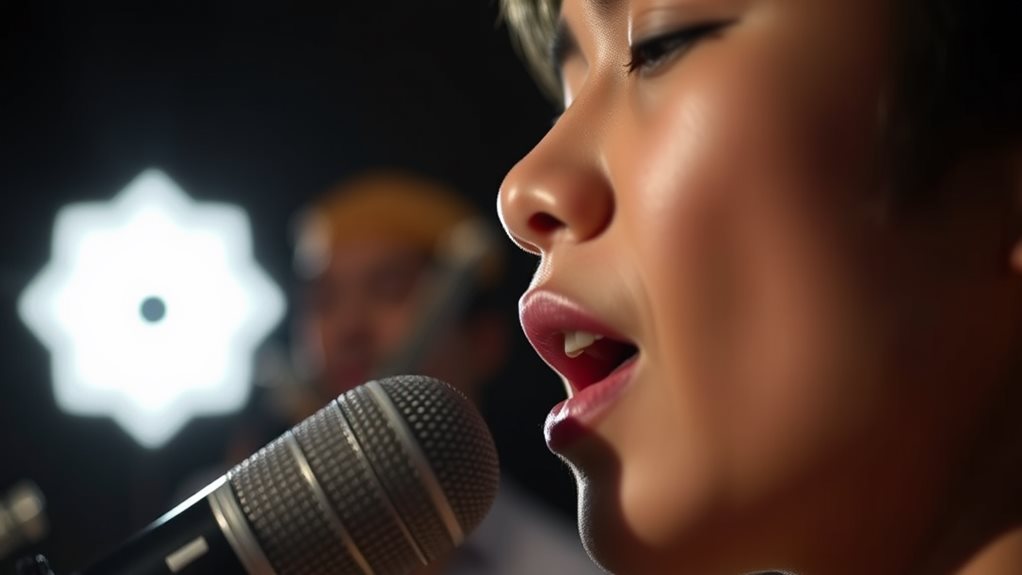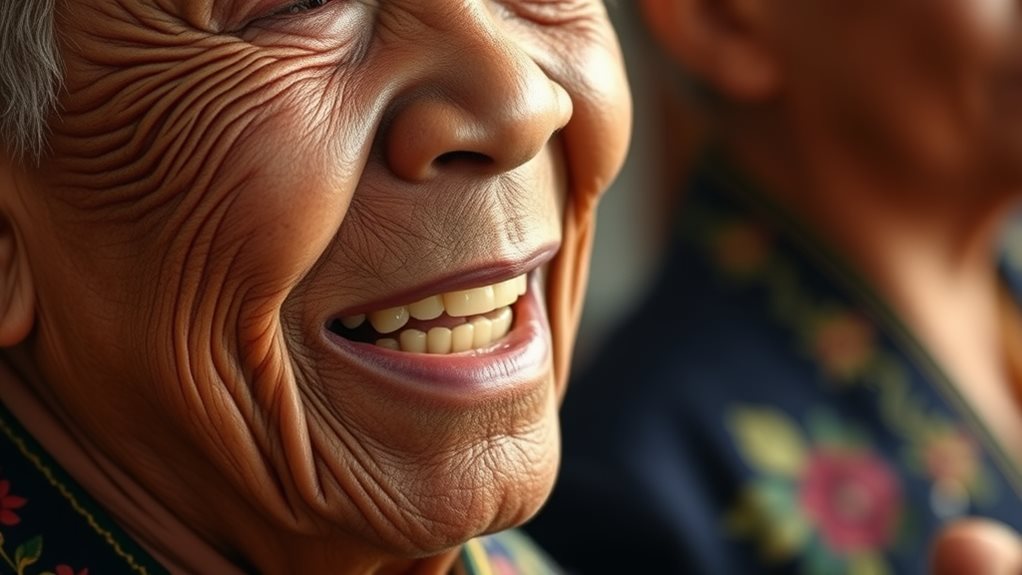Traditional Filipino vocal techniques involve a combination of fundamental skills and regionally diverse styles. This blend of skills is crucial for mastering Filipino music. Proper posture and diaphragmatic breathing are essential skills in Filipino vocal techniques. These skills are combined with regionally diverse styles, such as the *Hudhud* chants from the northern mountains and the *Kulintang* music of the southern Philippines.
Filipino vocal techniques are influenced by various cultures. These influences include indigenous traditions, Spanish, Islamic, and Chinese elements. For example, the *kundiman* genre, which originated during the Spanish period, is characterized by soulful and emotive melodies.
Mastering specific techniques is crucial for performing certain genres. Techniques like vibrato and trills are essential for performing genres such as *kundiman* and *harana*. Vibrato, which involves slightly varying the pitch, adds emotional depth to the music. Trills, which involve rapidly alternating between two notes, add a decorative touch to the melody.
Community singing plays a vital role in Filipino culture. It fosters cultural preservation and emotional impact. Community singing brings people together, promoting a sense of unity and shared heritage. It also helps to preserve traditional music and pass it down to future generations.
Vocal Techniques Fundamentals

Mastering traditional Filipino vocal techniques begins with understanding fundamental principles. Proper posture is essential for supporting breathing and vocal production. To maintain this posture, stand upright and avoid any back collapse. This optimal body alignment optimizes respiratory and vocal functions, crucial for vocal health.
Effective breathing techniques are vital for sustaining airflow. To expand lung capacity, inhale through your nose or mouth and expand your rib cage during inhalation. Avoid rib cage collapse when releasing air slowly, as this sustains airflow. Diaphragmatic breathing provides stable vocal support, enhancing vocal endurance through deep, sustained breaths.
Articulation and diction require specific exercises. Start with lip trills to warm up your facial muscles, followed by tongue stretches to improve flexibility. Practice smiling and stretching to relax your face. Vowel sounds ensure proper placement and resonance in your resonance training.
Vocal warm-ups are crucial for long-term vocal health. Begin with low notes and gradually ascend and descend, integrating kinetic movements to connect physical and vocal expression. Diaphragmatic support is essential for sustaining notes and pitches, avoiding throat strain.
Combine small air releases with vocal techniques to prepare your vocal mechanism.
Regional Vocal Traditions
The Philippines' rich cultural heritage is reflected in its unique vocal traditions.
The country's diverse geography and history have given rise to numerous distinct vocal traditions. These traditions often reflect the specific cultural heritage of a region.
In the Cordillera region, rich Indigenous narratives are primarily transmitted orally. This is demonstrated by the *Hudhud* and *Ullalim* epic chants, performed during significant life events such as harvests and funerals. These chants showcase the profound solemnity of funeral chants** and the festive atmosphere of harvest recitations**.
The chants are often accompanied by *Gangsa* and bamboo instruments, highlighting the intricate interplay of individual rhythmic patterns that create complex melodies. Specific vocal styles, like the *ba-diw* and *alim*, feature techniques such as trills, vibrato, and glottal stops.
Community singing is a vital part of Cordillera culture, with elders passing down songs and dances through observation. This oral tradition has allowed Indigenous narratives to be preserved across generations, demonstrating the longevity of oral tradition in preserving cultural heritage.
The tradition also showcases the powerful emotional resonance of community singing**** within the Cordilleran context.
In contrast, the southern Philippines is home to the vibrant Kulintang traditions. These ancient musical practices are central to Muslim and animist communities****, featuring bossed gongs played in ensembles.
The Maguindanaon and Maranao have their unique styles, which accompany rituals and dances. The Kulintang's resonant tones create a breathtaking interplay of sound and movement in performances.
The Philippines' vocal traditions are integral facets of cultural identity and practice, deeply woven into the fabric of daily life. These regional variations demonstrate the breadth and depth of Filipino vocal artistry, showcasing the country's rich cultural heritage.
Melodic Structures and Styles

Filipino vocal music is characterized by diverse melodic structures and styles. To understand this diversity, it's essential to examine the different genres. For example, the *harana* is typically sung in a 2/4 meter, while the *kundiman* is often in a 3/4 meter. The *kundiman* also features a dynamic melodic structure, often starting in a minor key and shifting to a major key.
Ornamentation techniques enrich the melodic fabric. Techniques such as trills, vibrato, slides, and glottal stops are used to enhance the melody. These techniques contribute to the wide stylistic spectrum of Filipino vocal music, which ranges from syllabic and speech-like to highly melismatic.
Different genres have distinct melodic structures. Solo singing is common in children's songs and serenades. The Ibaloy *ba-diw*, on the other hand, features call-and-response patterns between groups. The Visayan *balitaw* creates dramatic musical exchanges through vocal dialogues.
Shamanic singing, such as the *sanghiyang*, gradually shifts from speech-like patterns to more melodic vocalizations.
Regional distinctions are evident in Filipino vocal music. The Kalinga *oggayam* is distinct from the Tagalog *huluna*. Different regions also have unique ornamentation techniques and melody variations, adding to the complexity and diversity of Philippine vocal music.
These stylistic variations aren't only found in the melodies themselves but also in the cultural and ritual contexts in which these songs are performed.
Ensemble and Group Singing
Filipino Ensemble Singing Emphasizes Community Spirit****
Filipino musical traditions feature a rich variety of ensemble and group singing practices that showcase the country's communal nature. This style of singing is deeply ingrained in various cultural contexts, including religious ceremonies and festive gatherings. In these events, achieving group harmony is crucial, requiring coordination and a shared understanding of melodic structures.
Regional Variations in Ensemble Singing
Different regions in the Philippines have their unique forms of ensemble singing. In the Cordillera, the Kalinga and Ifugao showcase distinctive styles with unique instrumental accompaniments.
The Visayas feature the balitaw, a poetic exchange through song, while Southern Philippines showcase kulintang traditions, involving complex rhythmic interplay between gongs and voices. These variations highlight the rich diversity within Filipino musical practices.
Structured and Spontaneous Approaches in Group Singing
The roles within group singing are equally fascinating. In some traditions, a structured approach is used, with designated leaders guiding the group to maintain rhythmic accuracy and melodic consistency.
In others, communal participation is more spontaneous, focusing on collective expression. Group singing plays a significant role in various social functions, including healing ceremonies and courtship rituals, underscoring the importance of communal bonds.
Emotional Impact of Group Singing
The emotional impact of group singing is immense. Dozens of voices blending in perfect harmony during a significant cultural event create a profound sense of unity and connection.
Participating in a healing ceremony where group singing is central can be deeply moving and therapeutic. The use of various instruments further enhances the richness of Filipino group singing, contributing to the overall sonic texture and cultural significance.
Foreign Cultural Influences

Filipino group singing is deeply rooted in community and reflects centuries of interaction with other cultures. This interaction is evident in the cultural exchange between indigenous practices and foreign influences, resulting in musical fusion. For instance, the Spanish colonial era introduced stringed instruments like the guitar and harp, shaping lyrical forms like the harana and kundiman. The habanera rhythm in harana contrasts with the pre-colonial 3/4 time signature in kundiman, showcasing the complex interplay between old and new.
The Spanish influence extended beyond instruments to musical forms themselves. This blending of indigenous and Western aesthetics created a unique sound. The use of flat *chau* gongs, influenced by Chinese culture, contributed to the development of gong music in various regions. This cultural exchange may have also influenced the evolution of kulintang music.
Islamic influences are strongly present in the southern Philippines. This is particularly evident in the kulintang music, which demonstrates melodic autonomy and is used in ceremonies like the kapagipat. The distinct bossed gongs of Muslim and animist groups further highlight this cultural diversity.
Western and Christian influences interwoven with pre-existing traditions created new forms like the awit. This long narrative song is a prime example of musical fusion. The Pasyon chants exemplify the preservation of indigenous vocal styles within a Christian context.
The rich legacy of musical fusion has shaped Filipino vocal traditions through centuries of cultural exchange and the sophisticated integration of diverse musical elements.
Cultural Significance of Song
Filipino Traditional Songs: More Than Just Entertainment
Traditional songs in the Philippines play a vital role in the country's cultural life. They're an integral part of cultural rituals, preserving history, and shaping community dynamics****. These songs aren't just melodies, but living testaments to Filipino identity.
In ceremonies like the Maguindanao's *kapagipat*, songs blend with movement, creating a powerful, holistic expression**. The vocal techniques used in these songs reflect each community's unique musical character. For example, the Maguindanao's *kapagipat* involves trills, vibrato, and slides that are specific to their culture. These songs are conduits to the spiritual realm, connecting with ancestors and preserving precolonial beliefs**.
Traditional songs also reflect the social fabric, illuminating community dynamics. The Kalinga's *gangsa* playing and the Ifugao's *gangha* aren't just musical acts, but expressions of social roles and responsibilities. The music itself signifies status and participation within the community. For instance, in Kalinga gatherings, the *gangsa* resonates, marking social roles and responsibilities.
The lyrics of these songs often prioritize deeper meaning over technical skill. They contain collective experiences and values, reflecting the community's history and struggles. The *Hudhud*, a traditional song, preserves generational knowledge, struggles, and triumphs. It is a crucial link between past, present, and future.
Preserving Vocal Heritage

Preserving Vocal Heritage Requires Documentation and Community Engagement****.
To effectively preserve a nation's diverse vocal traditions, a multifaceted approach is necessary. Comprehensive recording methods are crucial. High-quality audio recordings capture the nuances of vocal techniques, including trills, vibrato, and characteristic melodic structures. These recordings should be accompanied by detailed ethnographic notes, contextualizing the performances within their specific ritual or ceremonial contexts.
For example, in the Philippines, regional vocal styles can be recorded and documented. Detailed notes on improvisation are essential. Documenting how performers create and adapt melodic themes is vital to understanding the complexity of each style. This documentation not only serves as an archive but also as a resource for future generations.
Community engagement is essential for preservation. Community workshops provide a platform for transmitting knowledge and skills across generations. These interactive spaces allow younger individuals to learn from master performers, practicing complex vocal techniques and learning about the cultural significance of each style.
Active participation strengthens community bonds and fosters a sense of ownership over the vocal heritage. By combining meticulous documentation with vibrant community engagement, the rich traditions of Filipino vocal artistry can continue to thrive.
Modern Applications of Styles
Traditional Filipino Vocal Techniques in Modern Applications****
Traditional Filipino vocal techniques have found vibrant expression in contemporary contexts, enriching various aspects of modern life. These techniques are now used in Original Pilipino Music (OPM), theatre, and educational programs.
In OPM, artists blend traditional styles with modern production, resulting in a unique sound. The incorporation of techniques like trills and vibrato enhances emotional depth and authenticity. Traditional instruments like the kulintang often accompany these songs, further enriching the cultural experience.
In theatre and performance arts, traditional vocal techniques are used to create a powerful and captivating atmosphere. The sanghiyang's stylized speech seamlessly transitions into melodic vocalizations, creating a mystical atmosphere. Adaptations of epics like the Ifugao's Hudhud and Mansaka's Manggob showcase storytelling through music, adding depth and cultural context.
Educational programs actively preserve and promote traditional Filipino vocal techniques. Workshops teach styles like the Kalinga oggayam and Tagalog huluna, fostering cultural awareness and encouraging vocal innovation. These programs ensure the transmission of traditional techniques to future generations.
The emotional power of traditional Filipino vocal techniques is evident in three key areas:
- Modern OPM songs incorporating traditional vocal techniques evoke heart-wrenching beauty.
- Theatrical performances utilizing unique vocal styles create a captivating mystique.
- Educational programs focused on traditional vocal techniques preserve cultural heritage.
These modern applications showcase the versatility and enduring relevance of traditional Filipino vocal techniques.
Resources for Further Learning

Delving into Filipino Vocal Traditions Requires Diverse Resources
Exploring the richness of Filipino vocal traditions requires access to various scholarly resources and experiential learning opportunities. Key readings include books and academic journals on ethnomusicology and Philippine music history.
Specific regional styles, such as the Kalinga *oggayam* and the Tagalog *huluna*, offer insights into distinct vocal techniques, including the use of trills and vibrato.
Indigenous oral traditions, like the *Hudhud* and *Manggob* epics, provide valuable information on social and ceremonial contexts shaping vocal performance.
These works contain historical and cultural significance, allowing for a deeper understanding of vocal traditions.
Online courses specializing in Philippine music and vocal techniques are also essential. Universities and cultural institutions offer digital learning experiences covering various facets of Filipino musical heritage.
These courses provide supplementary knowledge on historical influences, from pre-colonial practices to the impact of colonization and Christianization.
Recordings of traditional performances can enhance learning.
Listen to interplay between vocalists and instrumentalists, such as the *kulintang* and *kudyapi*, and observe kinetic movements that often accompany vocal delivery.
Questions and Answers
What Instruments Accompany Filipino Vocal Music?
Filipino vocal music is often accompanied by a variety of instruments. Instruments such as flutes, lutes, drums, gongs, and xylophones are commonly featured. These instruments can be found in traditional ensembles, which vary by region.
How Do Vocal Techniques Differ by Age Group?
Vocal techniques differ significantly across age groups.
Youth techniques, typically applied to singers under the age of 18, focus on establishing strong foundational skills. This includes developing proper breathing, posture, and pitch accuracy. Effective youth vocal techniques also prioritize vocal safety, as young voices are more susceptible to injury. For example, vocal coaches often emphasize gentle warm-ups and cool-downs to prevent vocal strain in young singers.
In contrast, senior styles, often applied to singers over the age of 40, prioritize vocal health and preservation. As singers age, their vocal cords naturally become less flexible, and their breathing capacity may decrease. To compensate, senior vocal techniques focus on efficient breathing, relaxed vocal placement, and careful pitch selection. This approach helps maintain vocal quality and prevent further wear on the vocal cords. Additionally, senior singers often focus on interpreting traditional repertoires, using their life experience and emotional depth to add nuance to their performances.
Are There Specific Vocal Styles for Healing?
Healing chants are an integral part of specific healing rituals and hold significant cultural significance.
These chants are more than just songs; they're deeply rooted in cultural beliefs and practices. For example, Tibetan chanting is used in Buddhist meditation to promote healing, balance, and inner peace. Similarly, Native American chanting is used in traditional healing ceremonies to connect with nature and the spirit world. In these cultures, chanting is believed to have the power to heal physical, emotional, and spiritual ailments.
How Has Technology Impacted Filipino Vocal Music?
The digital transformation of Filipino vocal music has significantly impacted its distribution, consumption, and creation. Virtual performances have become common, allowing artists to reach a wider audience. For instance, many Filipino singers have leveraged social media platforms like YouTube, Facebook, and TikTok to share their music and connect with fans worldwide.
AI-assisted production has also revolutionized the music creation process. With software like Amper Music and AIVA, musicians can now compose and produce music more efficiently. These tools use algorithms to generate beats, melodies, and harmonies, enabling artists to focus on other aspects of music creation.
In addition, online music education has made learning more accessible. Websites like MasterClass and Skillshare offer online courses and tutorials on vocal techniques, music theory, and songwriting. These resources have democratized music education, allowing aspiring singers to develop their skills without geographical constraints.
Where Can I Find Filipino Vocal Music Recordings?
Filipino vocal music recordings can be found in various recording sources. You can explore digital archives such as the International Music Score Library Project (IMSLP) and the National Library of the Philippines' digital collections. Online platforms like Spotify, YouTube Music, and Apple Music also offer a wide range of Filipino vocal music recordings. In the Philippines, libraries like the UP Diliman Main Library and the Cultural Center of the Philippines Library provide access to these recordings. Additionally, cultural centers like the Bahay Nakpil-Bautista and the Museo ng Maynila also have collections of Filipino vocal music recordings.